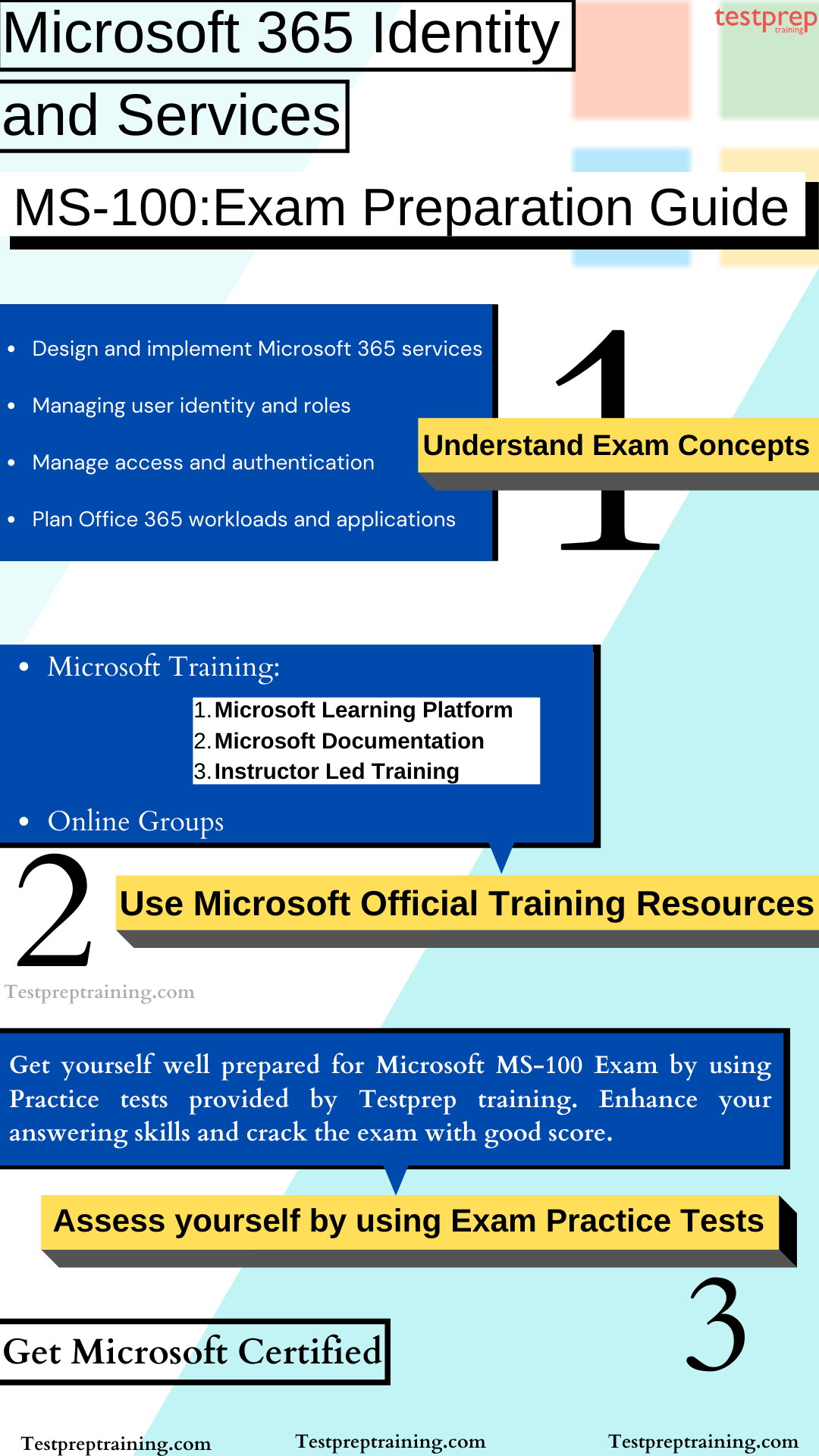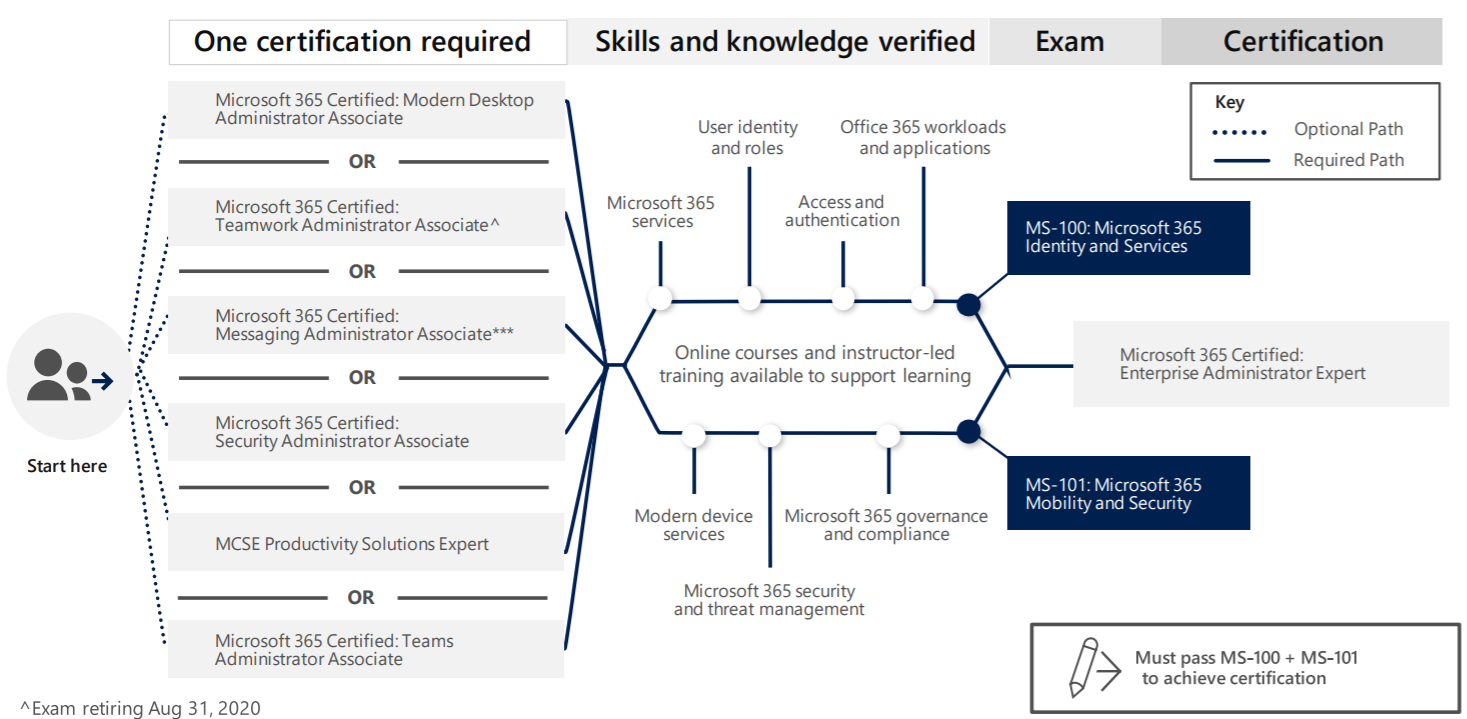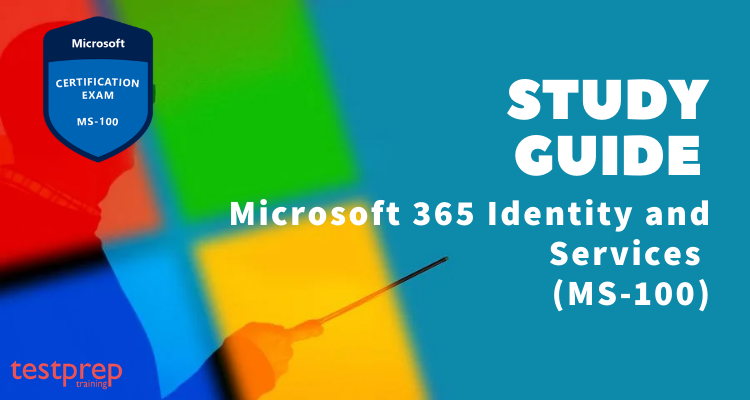Microsoft 365 is widely used in the industry, and having Microsoft 365 Identity and Services knowledge can significantly enhance an individual’s employability and career growth. By obtaining the Microsoft 365 Certified: Enterprise Administrator Expert certification, IT professionals can demonstrate their expertise and stand out in the competitive job market. Exam MS-100 is a certification exam offered by Microsoft that focuses on Microsoft 365 Identity and Services. You need to pass this test to get the Microsoft 365 Certified: Enterprise Administrator Expert certificate. This certificate shows that you know how to handle Microsoft 365 services and user accounts well.
The MS-100 exam is one of the two exams required to get the Microsoft 365 Certified: Enterprise Administrator Expert certification. So, naturally, in order to become a Microsoft 365 Certified: Enterprise Administrator Expert, one has to qualify for two exams. These include-
- Microsoft 365 Identity and Services (MS-100)
- Microsoft 365 Mobility and Security (MS-101)
The Microsoft 365 Identity and Services (MS-100) exam is meant for people who work as Microsoft 365 Enterprise Administrators. These folks should be skilled at checking, planning, moving, setting up, and looking after Microsoft 365 services. They also have to handle different tasks related to Microsoft 365 for a big company, such as user accounts, security, following rules, and related technologies.
Knowledge Required for the Exam
For IT experts dealing with Microsoft 365, knowing Microsoft 365 Identity and Services really well is super important. It’s a key part of handling and looking after Microsoft 365 services. Plus, having this knowledge can assist them in spotting and lessening security dangers and making sure they follow the rules correctly.
- Candidates applying for the exam should have a working knowledge of Microsoft 365 workloads.
- They must have been an administrator for at least one Microsoft 365 workload (Exchange, SharePoint, Skype for Business, or Windows as a Service).
- Moreover, they should also have a working knowledge of networking, server administration, and IT fundamentals such as DNS, Active Directory, and PowerShell.
- It is recommended that individuals preparing for the exam have hands-on experience with Microsoft 365 services and have a deep understanding of identity management and networking technologies.
Learning Objectives
The exam covers a range of topics related to Microsoft 365 Identity and Services, including:
- Designing and implementing Microsoft 365 services
- Managing user identity and roles
- Managing access and authentication
- Planning and implementing Microsoft 365 services
- Managing user devices and data
- Implementing and managing compliance and governance features in Microsoft 365
Target Audience
The MS-100 exam is primarily targeted at IT professionals who are responsible for managing Microsoft 365 services and identities. The exam is designed for individuals who are looking to validate their skills and knowledge in managing Microsoft 365 services and who are interested in obtaining the Microsoft 365 Certified: Enterprise Administrator Expert certification.
The target audience for the exam includes:
- IT experts in charge of handling Microsoft 365 services and user accounts.
- Administrators overseeing user accounts, licenses, and logins.
- IT specialists designing and setting up Microsoft 365 services.
- Security experts handling compliance and rules in Microsoft 365.
- Network administrators managing network setup and security in a Microsoft 365 setup.
Now that you have acquired all the information regarding the MS-100 exam, let’s begin with the study guide. However, if you wish to grasp in-depth information, then you can visit the Tutorial page here!
Study Guide 
There is no doubt that the moment we start preparing for any examination, we’re stuck between the two important questions. These include- which topic is the most important one and where to get all the reliable information. So, our main goal is to provide with such learning resources that you’re certified in the very first attempt. And, we promise you that if you work according to the given preparatory guide. Then, you becoming certified is certain.

Review all the Exam Objectives 
The MS-100 exam covers a range of topics related to Microsoft 365 Identity and Services. Below is a detailed description of each exam objective and topic:
The course Outline for the Microsoft MS-100 exam was updated on February 3, 2023
1. Deploy and manage a Microsoft 365 tenant (15—20%)
Plan and implement a Microsoft 365 tenant
- plan a tenant (Microsoft Documentation: Plan your tenant in Microsoft 365)
- create a tenant (Microsoft Documentation: Set up your Microsoft 365 tenant)
- implement and manage domains (Microsoft Documentation: Add a domain to Microsoft 365)
- configure organizational settings, including security, privacy, and profile (Microsoft Documentation: Use policy settings to manage privacy controls)
Monitor Microsoft 365 tenant health
- create and manage service requests (Microsoft Documentation: Manage service requests in Service Manager)
- create an incident response plan (Microsoft Documentation: Incident response planning)
- monitor service health check (Microsoft Documentation: Microsoft 365 service health)
- monitor application access (Microsoft Documentation: Microsoft 365 Apps monitoring)
- configure and review reports, including Azure Monitor logs and Log Analytics workspaces (Microsoft Documentation: Create a Log Analytics workspace)
- schedule and review usage metrics, including Microsoft Viva Insights and Adoption Score
2. Plan and manage user identity and roles (30—35%)
Plan identity synchronization
- design synchronization solutions for multitenant and multi-forest scenarios (Microsoft Documentation: Topologies for Azure AD Connect)
- evaluate whether objects should be synchronized, not synchronized, or created as cloud-only (Microsoft Documentation: One or more objects don’t sync, End-to-end troubleshooting of Azure AD)
- identify which Azure AD Connect features to enable, such as writeback and device synchronization (Microsoft Documentation: Custom installation of Azure Active Directory Connect)
- identify synchronization pre-requisites, including connectivity method, permissions, and server requirements (Microsoft Documentation: Set up directory synchronization for Microsoft 365)
- choose between Azure AD Connect and Azure AD Connect cloud sync
- plan user sign-in for Azure AD hybrid identities, including pass-through authentication, seamless, and SSO (Microsoft Documentation: Choose the right authentication method, Azure Active Directory Seamless Single Sign-On)
Implement and manage identity synchronization with Azure AD
- prepare for identity synchronization by using IdFix (Microsoft Documentation: Prepare for identity synchronization to Microsoft 365)
- configure and manage directory synchronization by using Azure AD Connect cloud sync (Microsoft Documentation: Create a new configuration for Azure AD)
- configure and manage directory synchronization by using Azure AD Connect
- configure Azure AD Connect object filters (Microsoft Documentation: Azure AD Connect sync: Configure filtering)
- monitor synchronization by using Azure AD Connect Health (Microsoft Documentation: Azure AD Connect)
- troubleshoot Azure AD Connect synchronization (Microsoft Documentation: Understanding errors during Azure AD synchronization)
Plan and manage Azure AD identities
- plan Azure AD identities (Microsoft Documentation: Determine your cloud identity model)
- create and manage users (Microsoft Documentation: Microsoft 365 user accounts)
- create and manage guest users (Microsoft Documentation: Manage groups guest access)
- create and manage groups, including Microsoft 365 groups (Microsoft Documentation: Manage who can create Microsoft 365 Groups)
- manage and monitor Microsoft 365 license allocations (Microsoft Documentation: View Microsoft 365 licenses and services with PowerShell)
- perform bulk user management, including PowerShell (Microsoft Documentation: Create Microsoft 365 user accounts with PowerShell)
Plan and manage roles in Microsoft 365
- plan for role assignments (Microsoft Documentation: Roles for Microsoft 365 services in Azure Active Directory)
- manage roles in Microsoft 365 admin center (Microsoft Documentation: admin roles in the Microsoft 365 admin center)
- manage administrative units (Microsoft Documentation: Administrative units in Azure Active Directory)
- plan and implement privileged identity management for Azure AD roles (Microsoft Documentation: Azure AD Privileged Identity Management)
3. Manage access and authentication (20—25%)
Plan and implement authentication
- choose an authentication method, including Windows Hello for Business, passwordless, and tokens (Microsoft Documentation: Passwordless authentication options for Azure Active Directory)
- implement and manage authentication methods (Microsoft Documentation: authentication and verification methods)
- implement and manage self-service password reset (SSPR) (Microsoft Documentation: Azure AD SSPR)
- implement and manage Azure AD password protection (Microsoft Documentation: Azure AD Password Protection for Active Directory Domain Services)
- configure and manage multi-factor authentication (MFA) (Microsoft Documentation: Set up multifactor authentication for Microsoft 365)
- investigate and resolve authentication issues (Microsoft Documentation: Troubleshoot Azure Multi-Factor Authentication issues)
Plan and implement secure access
- plan and implement access reviews in Azure AD identity governance (Microsoft Documentation: Azure AD access reviews)
- plan and implement entitlement packages in Azure AD identity governance (Microsoft Documentation: Azure AD entitlement management)
- plan for identity protection (Microsoft Documentation: Identity Protection)
- implement and manage Azure AD Identity Protection (Microsoft Documentation: Manage Azure AD Identity Protection)
- plan conditional access policies (Microsoft Documentation: Conditional Access)
- implement and manage conditional access policies
Plan and implement application access
- plan access and authentication to application registrations and Azure AD enterprise applications (Microsoft Documentation: applications application management in Azure Active Directory)
- configure application registration in Azure AD (Microsoft Documentation: Register an app with Azure Active Directory)
- manage user permissions for application registrations (Microsoft Documentation: Azure AD built-in roles)
- manage OAuth application requests in Azure AD, Microsoft Defender for Cloud Apps, and Microsoft 365 Defender (Microsoft Documentation: OAuth app policies)
- configure Azure AD Application Proxy (Microsoft Documentation: Using Azure AD Application Proxy)
- publish enterprise applications in Azure AD (Microsoft Documentation: Submit a request to publish your application)
4. Plan Microsoft 365 workloads and applications (20—25%)
Plan and implement Microsoft 365 Apps deployment
- plan for client connectivity to Microsoft 365 workloads (Microsoft Documentation: Microsoft 365 network connectivity principles)
- plan Microsoft 365 App compatibility by using the Readiness Toolkit (Microsoft Documentation: Use the Readiness Toolkit to assess application compatibility)
- plan for Microsoft 365 Apps updates (Microsoft Documentation: Overview of the update process for Microsoft 365 Apps)
- specify initial configuration for Microsoft 365 Apps by using the Microsoft 365 Apps admin center (Microsoft Documentation: Set up Microsoft 365 Apps for business)
- implement Microsoft 365 Apps deployment and software downloads (Microsoft Documentation: Overview of the Microsoft 365 Apps admin center)
Plan and implement Exchange Online deployments
- plan for DNS records required by Exchange Online (Microsoft Documentation: External Domain Name System records for Office 365)
- plan and implement an Exchange hybrid organization (Microsoft Documentation: Exchange Server hybrid deployments)
- plan and implement mail routing, including connectors, mail flow rules, and remote domains (Microsoft Documentation: Set up connectors to route mail between Microsoft 365)
- plan and implement organizational settings (Microsoft Documentation: Plan and manage organizational settings with Exchange Online)
Plan and implement Microsoft SharePoint Online, OneDrive, and Microsoft Teams
- specify SharePoint site types, site collections, and lists (Microsoft Documentation: Overview of sites and site collections in SharePoint Server)
- plan a migration strategy for SharePoint Online and OneDrive (Microsoft Documentation: Overview of the SharePoint Migration Tool (SPMT))
- identify hybrid requirements for SharePoint Online (Microsoft Documentation: Hardware and software requirements for SharePoint hybrid)
- manage access configurations for SharePoint Online and Microsoft Teams (Microsoft Documentation: Manage sharing settings)
- manage SharePoint Online tenant and site settings (Microsoft Documentation: SharePoint Online tenant properties)
- map Phone System features to requirements (Microsoft Documentation: Microsoft 365 and Office 365 platform service description)
- plan and implement organizational settings (Microsoft Documentation: Plan and manage organizational settings with Exchange Online)
- plan, implement, and manage guest and external access (Microsoft Documentation: Guest users in Microsoft 365 admin center)
Understand the key concepts and technologies
key concepts and technologies
To prepare for the MS-100 exam and succeed in managing Microsoft 365 services and identities, it is important to have a good understanding of key concepts and technologies related to Microsoft 365 Identity and Services. Here are some of the key concepts and technologies:
- Azure Active Directory (Azure AD): Azure AD is like Microsoft’s online tool for managing who can access what. It’s handy because you can control who gets into stuff, whether it’s stored in the cloud or on your own computers.
- Single Sign-On (SSO): SSO is a feature that allows users to log in once and access multiple applications and resources without the need to enter separate login credentials for each application.
- Multi-Factor Authentication (MFA): MFA is a safety measure that asks users to give more proof they’re who they say they are. This could be a special code or even their fingerprint, along with their usual username and password.
- Exchange Online: Exchange Online is a cloud-based email and calendaring service provided by Microsoft 365. It allows users to access their email and calendar from anywhere and on any device.
- SharePoint Online: SharePoint Online is a cloud-based collaboration and document management platform provided by Microsoft 365. It allows users to create and share documents, collaborate with others, and manage content in a secure and organized way.
- Microsoft Teams: Microsoft Teams is a collaboration platform provided by Microsoft 365. It allows users to chat, share files, and collaborate on projects in real time.
- PowerShell: PowerShell is like a computer tool that uses text commands to control Microsoft 365 stuff. It’s useful for making jobs automatic and handling big changes.
Microsoft 365 Learning Path
Microsoft offers test learning paths that assist students in comprehending and being familiar with the ideas while preparing. Also, these exam concepts are broken down into parts and subsections to help you study them thoroughly. Microsoft gives potential employees access to a learning route that explains topics to them step-by-step. This comprises:
- Deploy and manage a Microsoft 365 tenant
- Plan and manage user identity and roles
- Manage access and authentication
- Plan Microsoft 365 workloads and applications
Microsoft MS-100 Certification Path

Try Microsoft Training 
Indeed, certification is incomplete without training. Even the MS-100 certification preparatory guide highlights the importance of the two official ways to obtain training for the MS-100 exam. To enrol in the training course, Microsoft offers two types of training courses. On one hand, you have free online training and on the other, paid instructor-led training. So, make your decision wisely.
Read a Book Mate 
Books are great for learning, and Microsoft even has its own book store. Don’t hold back on expanding your knowledge. So, we strongly suggest the following:
- Exam Ref MS-100 Microsoft 365 Identity and Services by Orin Thomas
Join the Community 
Using online chat groups and study teams is a smart way to get ready for the MS-100 exam. Don’t hesitate to reach out to other test-takers in forums or online groups if you have any tough questions about the topic.
Practice Tests 
And, finally, it’s time for practice sessions. Take it from us, Self Evaluation is the only step you need in the end. The more you’re going to practice, it’s better for you. Not only does it helps you understand the areas where you lack but also, ensure you’re strengthening your skills as well. So, go through as many practice tests as much you can. FOR MORE PRACTICE TEST, CLICK HERE!
Ways to build practical experience with Microsoft 365 Identity and Services:
Building practical experience with Microsoft 365 Identity and Services is crucial for individuals looking to pass the MS-100 exam and succeed in managing Microsoft 365 services and identities. Here are some ways to build practical experience:
- Practice in a test environment: Create a test environment using a trial version of Microsoft 365, and practice implementing and managing various Microsoft 365 services, such as Exchange Online, SharePoint Online, and Teams. This will help you gain hands-on experience with Microsoft 365 services and prepare you for the exam.
- Participate in Microsoft 365 projects: Participate in Microsoft 365 projects at your workplace or volunteer to assist with Microsoft 365 implementations for non-profit organizations. This will provide you with practical experience in implementing and managing Microsoft 365 services.
- Attend training courses: Attend training courses offered by Microsoft or other training providers to gain in-depth knowledge and practical experience in managing Microsoft 365 services.
- Participate in online communities: Participate in online communities, such as Microsoft Tech Community, where you can connect with other professionals and share your knowledge and experience in managing Microsoft 365 services.
- Use Microsoft 365 administrative tools: Use Microsoft 365 administrative tools, such as the Microsoft 365 Admin Center and PowerShell, to manage and troubleshoot Microsoft 365 services. This will help you gain practical experience in managing Microsoft 365 services and familiarize yourself with the administrative tools used in the industry.
Why take Microsoft MS-100 Exam?
If you’re looking to advance your career in the IT industry and demonstrate your skills in managing Microsoft 365 services and identities, pursuing the MS-100 exam and Microsoft 365 Identity and Services certification can be a great way to do so.
Here are a few reasons why you should consider pursuing the MS-100 exam and Microsoft 365 Identity and Services certification:
- In-demand skills: Microsoft 365 is a widely used cloud-based platform, and the demand for professionals with skills in managing Microsoft 365 services and identities is growing. When you get the Microsoft 365 Identity and Services certification, you’re showing future employers that you know how to handle Microsoft 365 services well.
- Career advancement: Earning the Microsoft 365 Identity and Services certification can help you advance your career in IT. With this certification, you can pursue roles such as Microsoft 365 administrator, cloud administrator, or IT manager.
- Validation of skills: By passing the MS-100 exam and earning the Microsoft 365 Identity and Services certification, you’ll validate your skills and knowledge in managing Microsoft 365 services and identities. This can provide you with a sense of accomplishment and boost your confidence in your abilities.
- Access to resources: Microsoft provides a range of resources to support individuals pursuing the Microsoft 365 Identity and Services certification, including study guides, practice exams, and training courses. These resources can help you prepare for the exam and gain the skills and knowledge needed to manage Microsoft 365 services effectively.
Prepare and pass the Microsoft Identity and Services (MS-100) Exam.



